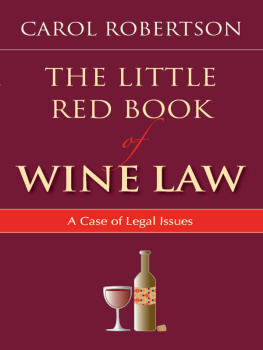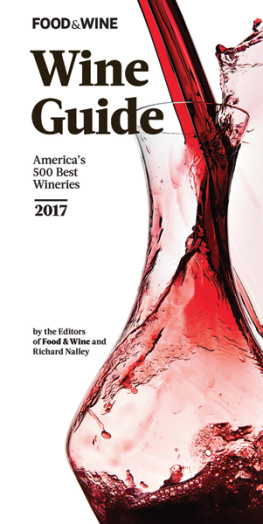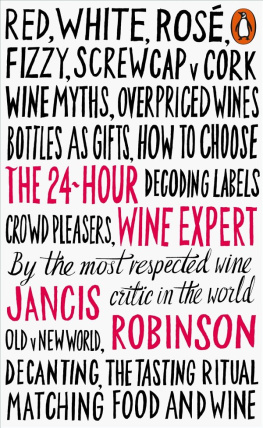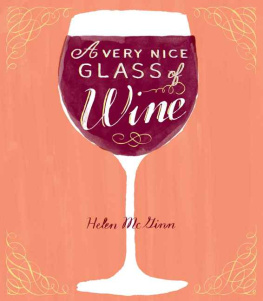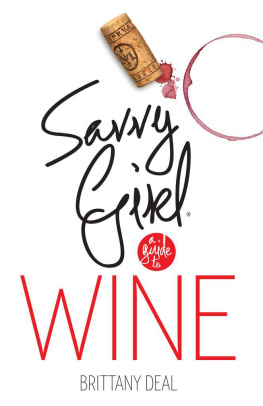From Demon to Darling
From Demon to Darling

A LEGAL HISTORY OF WINE IN AMERICA
Richard Mendelson
Foreword by Margrit Biever Mondavi

University of California Press, one of the most distinguished university presses in the United States, enriches lives around the world by advancing scholarship in the humanities, social sciences, and natural sciences. Its activities are supported by the UC Press Foundation and by philanthropic contributions from individuals and institutions. For more information, visit www.ucpress.edu .
University of California Press
Berkeley and Los Angeles, California
University of California Press, Ltd.
London, England
2009 by The Regents of the University of California
Library of Congress Cataloging-in-Publication Data
Mendelson, Richard.
From demon to darling: a legal history of wine in
America / Richard Mendelson; foreword by Margrit
Biever Mondavi.
p. cm.
Includes bibliographical references and index.
ISBN: 978-0-520-25943-0 (cloth : alk. paper)
1. Wine and wine makingLaw and legislation
United StatesHistory. I. Title. II. Title: Legal
history of wine in America.
KF3924.W5M46 2009 |
343.73'07864122dc22 | 2008034387 |
Manufactured in the United States of America
18 17 16 15 14 13 12 11 10 09
10 9 8 7 6 5 4 3 2 1
This book is printed on Natures Book, which contains
50% post-consumer waste and meets the minimum
requirements of ANSI/NISO Z39.481992 (R 1997)
(Permanence of Paper).
This book is dedicated to the memory of my parents,
Max and Naomi Mendelson
CONTENTS
ILLUSTRATIONS
WINE IS LIFE
A Foreword by Margrit Biever Mondavi
I have always been fascinatedand often amusedby the intersection of wine and law, especially here in America. I was born and raised, you see, in the canton Ticino, the Italian part of Switzerland. Every day our main meal, what we call lunch, was a celebration, and be it outside between rosebushes and hydrangeas or in our dining room, there was always a bottle of wine on the table. No fuss, no muss, it was part of our daily meal.
My first memories are of my little glass of water slightly tinted with wine and maybe a bit of sugar. As we grew up, it contained less water and more wine. Either way, wine was a natural part of the wonderful, delicious meals my mother cooked. It was an accepted part of daily life throughout Switzerland. I dont even know if there was a consumer alcohol law in Switzerland at that time. Today, though, wine and beer are permitted there for those sixteen years and older, and hard liquor for those eighteen years and older.
I was first married to an American in the U.S. military. Our first U.S. assignment was in Igloo, South Dakota, beginning in 1947. I was surprised, almost unbelieving, when I realized that wine and alcoholic beverages were looked upon as almost illicit. The first time we went to a party in South Dakota, for instance, I realized that you could not drink and dance in the same place. We danced on the second floor, and anytime somebody wanted a drink they went down to the first floor. Of course, that left the women upstairs and the men merrily drinking downstairs. South Dakota was not exactly a culinary heaven, but we did go to restaurants for steaks and baked potatoes. When I ordered wine I was definitely looked at askance, and they brought me only a thimble of sweet port. I believe that at the time, bars in South Dakotacalled saloonswere not allowed to have windows, so that women drinking inside could not be seen, and the entrances were in the rear. Laws were such in our county that no alcohol was sold on Sunday, but everybody went to the next county and loaded up the Chevrolet.
On our next assignment, in Spokane, I found that women (always referred to as ladies) were not allowed to carry a whiskey sour from a restaurants bar to its dining room. Only a waiter could do that. At that time, everybody started with a cocktail for the first course and then drank mugs of coffee with the rest of the dinner. (There was even a judging of which coffee went best with which pork chop!) Because of the Balkanized state of American wine laws and because of the reigning social mores, my first twenty years in the United States were pretty much wine-less.
When we moved to the Napa Valley, in 1960, I again had to wonder and laugh. The little town of Yountville had an old Veterans Home on its outskirts, housing over two thousand vets. It was not permitted to sell alcohol within 1.5 miles of the Homeand the little town of Yountville was exactly 1.5 miles from the Veterans Home! As a result, there were twenty-one bars in Yountville, most of them made of only cardboard and corrugated aluminum. Likewise, there was a fleet of ten taxicabs whose main job was to bring the lonely, thirsty vets back and forth. By contrast, the nearby town of Napa, with a population of seventeen thousand, had only one taxicab.
Still, when I settled into the Napa Valley, I truly thought, Eureka!this is it. And here I met a wonderful man. Wine was his passion. Bob Mondavi and I were married over twenty-seven happy years, and there wasnt a day that we didnt open a good bottle of wine. We usually opened it before supper, and by the evenings end the bottle was empty. Bob not only thought and acted like a European, he wanted to change Americas attitude toward wine and food. And when Bob had a project, he realized it. He worked hard and spent a lot of energy and money doing the industrys job in telling the truth about wine. His Mission programto promote wine as an integral part of our culture, our heritage, and the gracious way of lifeechoed across the country, and for this endeavor we brought together eminent artists, academics, and food and wine people. Dr. Curtis Ellison went on to star on the landmark CBS 60 Minutes program that explained why the French have a high-fat diet but very low rates of coronary heart disease, a phenomenon known as the French Paradox. That program changed, in a profound way, the image of wine in this country.
With only one exceptionregarding at what age young people can be served wine at the tableour country has made great strides when it comes to wine and law. In that regard, I still believe in the method we followed in Switzerland. We introduced tiny amounts of wine to the children, diluted for the younger ones, and to me that is the safest and most effective insurance against later alcohol misuse. I followed that method with my own three children, and it worked beautifully. They understand and appreciate wine but never abuse it.
Thanks to my unusual background, I read Richard Mendelsons history of wine law in America with great interest and appreciation. Richard tells the story in a clear and illuminating way. His book belongs in every wine library and winery and every other establishment that caters to wine and wine lovers. I wish Richard great success, and I congratulate him.
ACKNOWLEDGMENTS
This labor of love, which arose from my Wine Law class at the University of California, Berkeley School of Law (Berkeley Law), has been supported by many people who have shared their knowledge, research, insights, and perspectives. They include, in alphabetical order, Nicholas Bergman, Lou Bright, Federico Castellucci, Paul Chutkow, Joe Ciatti, Neil Cohen, Joe Criscione, Dan Davis, John DeLuca, Jon Fredrikson, Richard Gahagan, Harley Garrett, Lawrence Gedda, John Gillespie, Jim Goldberg, Steve Gross, George Hacker, Jerry Jolly, Wendell Lee, Kingsley Liu, John Manfreda, Robert Mondavi, Margrit Biever Mondavi, Vincent OBrien, Persis Ramroth, Dean Rowan, Jean-Claude Ruf, Hobert Rupe, James Seff, Jim Sgueo, Representative Mike Thompson, Robert Tinlot, Rob Tobiassen, Dotson Wilson, Chris Wirth, Lawrence Wu, and Robert Zerkowitz. I also owe debts of gratitude to a cadre of courteous, patient, and professional librarians and researchers at the American Medical Association, Berkeley Law, Giannini Foundation Library, California State Library, Franklin D. Roosevelt Presidential Library, Library of Congress, National Archives and Records Administration, and Wine Institute. Dean Rowan of Berkeley Law and Robert Zerkowitz of the Wine Institute, in particular, went above and beyond the call of duty.
Next page

